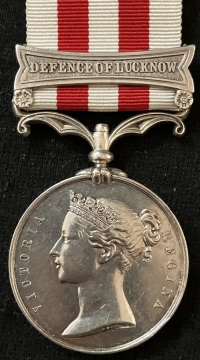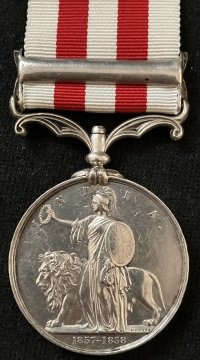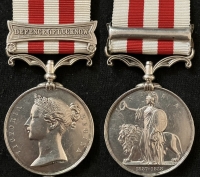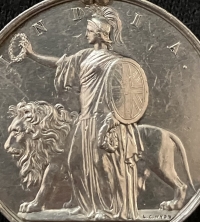

A Rare
INDIAN MUTINY MEDAL
(DEFENCE OF LUCKNOW)
-“TO AN ORIGINAL DEFENDER”-
(DIED OF WOUNDS 18th JULY 1857)
Received at
“BATTLE OF CHINHUT”
30th June 1857
To:
Cpl JOHN FORREST
32nd Foot Regiment.
[THE MEDAL]
Indian Mutiny Medal 1857-1859
(DEFENCE OF LUCKNOW)
Cpl J. FORREST 32ND L.I. (officially impressed)
Died of Wounds, 18th JULY 1857
From
Wounds Received on 30th June 1857
at
BATTLE of CHINHUT .
 A Rare & Classic “DEFENCE OF LUCKNOW” Indian Mutiny Medal. Casualty who died of wounds received at “THE BATTLE OF CHINHUT” 30th June 1857.
On 18th JULY 1857 JOHN FORREST Died of Wounds received during the infamous Battle of Chinhut on 30th June 1857. During this significant fight, a force ordered by Sir Henry Lawrence proceeded up the Faizabad road to meet an opponent force which was believed to be several hundred strong. However, the Lawrence force was suddenly fired upon by a force of over 6,000 rebels who were concealed in well prepared positions behind stone walls and in the village.
The 32nd Foot suffered heavy casualties both immediately and later of wounds received in this savage action and at the critical moment many of Lawrence's soldiers, especially Indian artillerymen, betrayed him by going over to the side of the mutineers overturning their guns and cutting the traces on the horses: 484 men and the Sikh cavalrymen fled.
The retreat from Chinhut was thus the pivotal action that lead to the eventual Siege of Lucknow which would last until November 1857.
A Rare & Classic “DEFENCE OF LUCKNOW” Indian Mutiny Medal. Casualty who died of wounds received at “THE BATTLE OF CHINHUT” 30th June 1857.
On 18th JULY 1857 JOHN FORREST Died of Wounds received during the infamous Battle of Chinhut on 30th June 1857. During this significant fight, a force ordered by Sir Henry Lawrence proceeded up the Faizabad road to meet an opponent force which was believed to be several hundred strong. However, the Lawrence force was suddenly fired upon by a force of over 6,000 rebels who were concealed in well prepared positions behind stone walls and in the village.
The 32nd Foot suffered heavy casualties both immediately and later of wounds received in this savage action and at the critical moment many of Lawrence's soldiers, especially Indian artillerymen, betrayed him by going over to the side of the mutineers overturning their guns and cutting the traces on the horses: 484 men and the Sikh cavalrymen fled.
The retreat from Chinhut was thus the pivotal action that lead to the eventual Siege of Lucknow which would last until November 1857.
 [BIOGRAPHY] —1st September 1857.
Serving during the Indian Mutiny, Cpl JOHN FORREST would die of wounds received in action at the Battle of Chinhut on 30th June 1857.
The Battle of Chinhut occurred when conflicting intelligence reports had indicated the approach of a small insurgent force towards Lucknow. Sir Henry Lawrence, who was in bad health, under pressure from subordinates and whose fighting days were well behind him, ordered a force consisting of three companies of the 32nd Regiment of Foot (later the Duke of Cornwall's Light Infantry), several companies of the 13th Native Infantry and detachments of other regiments, a small force of Sikh cavalry and European volunteer cavalry as well as Bengal Artillery (Europeans) and Native Artillery, to proceed up the Faizabad road with the intention of intercepting what he believed to be an opponent force several hundred strong. He was tragically ill informed as the British troops were outnumbered by 10 to 1.
On approaching Ismailganj, Lawrences's force was suddenly fired on by the insurgents, who greatly outnumbered the British, by about 600 to 6,000. The rebels were in well prepared positions, behind stone walls and in the village, and soon inflicted heavy casualties on Lawrence's force, especially the 32nd Foot.
[BIOGRAPHY] —1st September 1857.
Serving during the Indian Mutiny, Cpl JOHN FORREST would die of wounds received in action at the Battle of Chinhut on 30th June 1857.
The Battle of Chinhut occurred when conflicting intelligence reports had indicated the approach of a small insurgent force towards Lucknow. Sir Henry Lawrence, who was in bad health, under pressure from subordinates and whose fighting days were well behind him, ordered a force consisting of three companies of the 32nd Regiment of Foot (later the Duke of Cornwall's Light Infantry), several companies of the 13th Native Infantry and detachments of other regiments, a small force of Sikh cavalry and European volunteer cavalry as well as Bengal Artillery (Europeans) and Native Artillery, to proceed up the Faizabad road with the intention of intercepting what he believed to be an opponent force several hundred strong. He was tragically ill informed as the British troops were outnumbered by 10 to 1.
On approaching Ismailganj, Lawrences's force was suddenly fired on by the insurgents, who greatly outnumbered the British, by about 600 to 6,000. The rebels were in well prepared positions, behind stone walls and in the village, and soon inflicted heavy casualties on Lawrence's force, especially the 32nd Foot.
 The regiment's acting commanding officer, Lieutenant Colonel William Case, was killed, as were several officers. The 13th Native Infantry were slightly more successful in attacking to the right of the village, but the rebels were well entrenched and well led.
To this action can be attributed one of the few major victories which rebel forces obtained in open combat with the British, during the whole of the Indian Mutiny.
At a crucial moment, many of Lawrence's soldiers, especially Indian artillerymen, betrayed him by going over to the other side, overturning their guns and cutting the traces on the horses, 484 and the Sikh cavalrymen fled. As the British retreated towards the bridge over the Kukrail stream, the only access they had to Lucknow, an outflanking movement by the rebel cavalry threatened to cut them off. A charge by the 36 volunteer cavalrymen, consisting partly of civilians, threw the rebel cavalry into confusion and a significant part of the force was able to cross the bridge and retreat towards Lucknow. Lawrence ordered a battery of European artillery to occupy the bridgehead, with the intention of dissuading his enemy from following him. The artillery had no ammunition left, but achieved their aim of giving the retreating force a breathing space.
The regiment's acting commanding officer, Lieutenant Colonel William Case, was killed, as were several officers. The 13th Native Infantry were slightly more successful in attacking to the right of the village, but the rebels were well entrenched and well led.
To this action can be attributed one of the few major victories which rebel forces obtained in open combat with the British, during the whole of the Indian Mutiny.
At a crucial moment, many of Lawrence's soldiers, especially Indian artillerymen, betrayed him by going over to the other side, overturning their guns and cutting the traces on the horses, 484 and the Sikh cavalrymen fled. As the British retreated towards the bridge over the Kukrail stream, the only access they had to Lucknow, an outflanking movement by the rebel cavalry threatened to cut them off. A charge by the 36 volunteer cavalrymen, consisting partly of civilians, threw the rebel cavalry into confusion and a significant part of the force was able to cross the bridge and retreat towards Lucknow. Lawrence ordered a battery of European artillery to occupy the bridgehead, with the intention of dissuading his enemy from following him. The artillery had no ammunition left, but achieved their aim of giving the retreating force a breathing space.
 On the retreat, feats of great courage were performed by those who helped wounded and exhausted men to escape. Prominent among the rescuers were the native troops of the 13th NI, who often abandoned their own wounded in order to help British soldiers. An officer of the 13th NI, then Lieut. William George Cubitt, would be awarded the Victoria Cross for helping save three men of the 32nd Foot.
Seeing that the retreat would be generally successful, Lawrence left the force in order to organize the Defence of the Lucknow Residency. Brigadier John Inglis, commanding officer of the 32nd, who had opposed the 'adventure', was left to bring the survivors in. As a last attempt to break the momentum of the rebel pursuit, Lawrence ordered one company of the 32nd, which had not been at Chinhat, to hold the final bridge before Lucknow, over the Gumti river. The success of this company, under Lieut. John Edmondstone, and its orderly retreat under enemy pressure, probably helped save many lives.
By about 11:30 a.m, the retreat had been successfully completed. The British Residency at Lucknow, to which Lawrence withdrew, was then the scene of the Siege of Lucknow until November 1857.
On the retreat, feats of great courage were performed by those who helped wounded and exhausted men to escape. Prominent among the rescuers were the native troops of the 13th NI, who often abandoned their own wounded in order to help British soldiers. An officer of the 13th NI, then Lieut. William George Cubitt, would be awarded the Victoria Cross for helping save three men of the 32nd Foot.
Seeing that the retreat would be generally successful, Lawrence left the force in order to organize the Defence of the Lucknow Residency. Brigadier John Inglis, commanding officer of the 32nd, who had opposed the 'adventure', was left to bring the survivors in. As a last attempt to break the momentum of the rebel pursuit, Lawrence ordered one company of the 32nd, which had not been at Chinhat, to hold the final bridge before Lucknow, over the Gumti river. The success of this company, under Lieut. John Edmondstone, and its orderly retreat under enemy pressure, probably helped save many lives.
By about 11:30 a.m, the retreat had been successfully completed. The British Residency at Lucknow, to which Lawrence withdrew, was then the scene of the Siege of Lucknow until November 1857.

 [THE MEDAL]A SUMMARY
Wiithout doubt, Indian Mutiny medals to Original Defenders at Lucknow are some of the most desirable and sought after awards in the entire British campaign medal series.
Looking at the medal rolls it becomes clear just how many men perished either outright or as a result of serious wounds received during this famous action. Many men with serious wounds lingered on, some for many weeks, in a deteriorating condition with badly infected, septic and gangrenous wounds which due to the historical absence of such modern treatments as antibiotics, eventually killed them.
[THE MEDAL]A SUMMARY
Wiithout doubt, Indian Mutiny medals to Original Defenders at Lucknow are some of the most desirable and sought after awards in the entire British campaign medal series.
Looking at the medal rolls it becomes clear just how many men perished either outright or as a result of serious wounds received during this famous action. Many men with serious wounds lingered on, some for many weeks, in a deteriorating condition with badly infected, septic and gangrenous wounds which due to the historical absence of such modern treatments as antibiotics, eventually killed them.
 The medal is Extremely Fine with superb bright & fresh surfaces.
If you are a serious Indian Mutiny collector, you should certainly add Cpl JOHN FORREST’s classic medal to your collection.
£2995
The medal is Extremely Fine with superb bright & fresh surfaces.
If you are a serious Indian Mutiny collector, you should certainly add Cpl JOHN FORREST’s classic medal to your collection.
£2995
 A Rare & Classic “DEFENCE OF LUCKNOW” Indian Mutiny Medal. Casualty who died of wounds received at “THE BATTLE OF CHINHUT” 30th June 1857.
On 18th JULY 1857 JOHN FORREST Died of Wounds received during the infamous Battle of Chinhut on 30th June 1857. During this significant fight, a force ordered by Sir Henry Lawrence proceeded up the Faizabad road to meet an opponent force which was believed to be several hundred strong. However, the Lawrence force was suddenly fired upon by a force of over 6,000 rebels who were concealed in well prepared positions behind stone walls and in the village.
The 32nd Foot suffered heavy casualties both immediately and later of wounds received in this savage action and at the critical moment many of Lawrence's soldiers, especially Indian artillerymen, betrayed him by going over to the side of the mutineers overturning their guns and cutting the traces on the horses: 484 men and the Sikh cavalrymen fled.
The retreat from Chinhut was thus the pivotal action that lead to the eventual Siege of Lucknow which would last until November 1857.
A Rare & Classic “DEFENCE OF LUCKNOW” Indian Mutiny Medal. Casualty who died of wounds received at “THE BATTLE OF CHINHUT” 30th June 1857.
On 18th JULY 1857 JOHN FORREST Died of Wounds received during the infamous Battle of Chinhut on 30th June 1857. During this significant fight, a force ordered by Sir Henry Lawrence proceeded up the Faizabad road to meet an opponent force which was believed to be several hundred strong. However, the Lawrence force was suddenly fired upon by a force of over 6,000 rebels who were concealed in well prepared positions behind stone walls and in the village.
The 32nd Foot suffered heavy casualties both immediately and later of wounds received in this savage action and at the critical moment many of Lawrence's soldiers, especially Indian artillerymen, betrayed him by going over to the side of the mutineers overturning their guns and cutting the traces on the horses: 484 men and the Sikh cavalrymen fled.
The retreat from Chinhut was thus the pivotal action that lead to the eventual Siege of Lucknow which would last until November 1857.
 [BIOGRAPHY] —1st September 1857.
Serving during the Indian Mutiny, Cpl JOHN FORREST would die of wounds received in action at the Battle of Chinhut on 30th June 1857.
The Battle of Chinhut occurred when conflicting intelligence reports had indicated the approach of a small insurgent force towards Lucknow. Sir Henry Lawrence, who was in bad health, under pressure from subordinates and whose fighting days were well behind him, ordered a force consisting of three companies of the 32nd Regiment of Foot (later the Duke of Cornwall's Light Infantry), several companies of the 13th Native Infantry and detachments of other regiments, a small force of Sikh cavalry and European volunteer cavalry as well as Bengal Artillery (Europeans) and Native Artillery, to proceed up the Faizabad road with the intention of intercepting what he believed to be an opponent force several hundred strong. He was tragically ill informed as the British troops were outnumbered by 10 to 1.
On approaching Ismailganj, Lawrences's force was suddenly fired on by the insurgents, who greatly outnumbered the British, by about 600 to 6,000. The rebels were in well prepared positions, behind stone walls and in the village, and soon inflicted heavy casualties on Lawrence's force, especially the 32nd Foot.
[BIOGRAPHY] —1st September 1857.
Serving during the Indian Mutiny, Cpl JOHN FORREST would die of wounds received in action at the Battle of Chinhut on 30th June 1857.
The Battle of Chinhut occurred when conflicting intelligence reports had indicated the approach of a small insurgent force towards Lucknow. Sir Henry Lawrence, who was in bad health, under pressure from subordinates and whose fighting days were well behind him, ordered a force consisting of three companies of the 32nd Regiment of Foot (later the Duke of Cornwall's Light Infantry), several companies of the 13th Native Infantry and detachments of other regiments, a small force of Sikh cavalry and European volunteer cavalry as well as Bengal Artillery (Europeans) and Native Artillery, to proceed up the Faizabad road with the intention of intercepting what he believed to be an opponent force several hundred strong. He was tragically ill informed as the British troops were outnumbered by 10 to 1.
On approaching Ismailganj, Lawrences's force was suddenly fired on by the insurgents, who greatly outnumbered the British, by about 600 to 6,000. The rebels were in well prepared positions, behind stone walls and in the village, and soon inflicted heavy casualties on Lawrence's force, especially the 32nd Foot.
 The regiment's acting commanding officer, Lieutenant Colonel William Case, was killed, as were several officers. The 13th Native Infantry were slightly more successful in attacking to the right of the village, but the rebels were well entrenched and well led.
To this action can be attributed one of the few major victories which rebel forces obtained in open combat with the British, during the whole of the Indian Mutiny.
At a crucial moment, many of Lawrence's soldiers, especially Indian artillerymen, betrayed him by going over to the other side, overturning their guns and cutting the traces on the horses, 484 and the Sikh cavalrymen fled. As the British retreated towards the bridge over the Kukrail stream, the only access they had to Lucknow, an outflanking movement by the rebel cavalry threatened to cut them off. A charge by the 36 volunteer cavalrymen, consisting partly of civilians, threw the rebel cavalry into confusion and a significant part of the force was able to cross the bridge and retreat towards Lucknow. Lawrence ordered a battery of European artillery to occupy the bridgehead, with the intention of dissuading his enemy from following him. The artillery had no ammunition left, but achieved their aim of giving the retreating force a breathing space.
The regiment's acting commanding officer, Lieutenant Colonel William Case, was killed, as were several officers. The 13th Native Infantry were slightly more successful in attacking to the right of the village, but the rebels were well entrenched and well led.
To this action can be attributed one of the few major victories which rebel forces obtained in open combat with the British, during the whole of the Indian Mutiny.
At a crucial moment, many of Lawrence's soldiers, especially Indian artillerymen, betrayed him by going over to the other side, overturning their guns and cutting the traces on the horses, 484 and the Sikh cavalrymen fled. As the British retreated towards the bridge over the Kukrail stream, the only access they had to Lucknow, an outflanking movement by the rebel cavalry threatened to cut them off. A charge by the 36 volunteer cavalrymen, consisting partly of civilians, threw the rebel cavalry into confusion and a significant part of the force was able to cross the bridge and retreat towards Lucknow. Lawrence ordered a battery of European artillery to occupy the bridgehead, with the intention of dissuading his enemy from following him. The artillery had no ammunition left, but achieved their aim of giving the retreating force a breathing space.
 On the retreat, feats of great courage were performed by those who helped wounded and exhausted men to escape. Prominent among the rescuers were the native troops of the 13th NI, who often abandoned their own wounded in order to help British soldiers. An officer of the 13th NI, then Lieut. William George Cubitt, would be awarded the Victoria Cross for helping save three men of the 32nd Foot.
Seeing that the retreat would be generally successful, Lawrence left the force in order to organize the Defence of the Lucknow Residency. Brigadier John Inglis, commanding officer of the 32nd, who had opposed the 'adventure', was left to bring the survivors in. As a last attempt to break the momentum of the rebel pursuit, Lawrence ordered one company of the 32nd, which had not been at Chinhat, to hold the final bridge before Lucknow, over the Gumti river. The success of this company, under Lieut. John Edmondstone, and its orderly retreat under enemy pressure, probably helped save many lives.
By about 11:30 a.m, the retreat had been successfully completed. The British Residency at Lucknow, to which Lawrence withdrew, was then the scene of the Siege of Lucknow until November 1857.
On the retreat, feats of great courage were performed by those who helped wounded and exhausted men to escape. Prominent among the rescuers were the native troops of the 13th NI, who often abandoned their own wounded in order to help British soldiers. An officer of the 13th NI, then Lieut. William George Cubitt, would be awarded the Victoria Cross for helping save three men of the 32nd Foot.
Seeing that the retreat would be generally successful, Lawrence left the force in order to organize the Defence of the Lucknow Residency. Brigadier John Inglis, commanding officer of the 32nd, who had opposed the 'adventure', was left to bring the survivors in. As a last attempt to break the momentum of the rebel pursuit, Lawrence ordered one company of the 32nd, which had not been at Chinhat, to hold the final bridge before Lucknow, over the Gumti river. The success of this company, under Lieut. John Edmondstone, and its orderly retreat under enemy pressure, probably helped save many lives.
By about 11:30 a.m, the retreat had been successfully completed. The British Residency at Lucknow, to which Lawrence withdrew, was then the scene of the Siege of Lucknow until November 1857.

 [THE MEDAL]A SUMMARY
Wiithout doubt, Indian Mutiny medals to Original Defenders at Lucknow are some of the most desirable and sought after awards in the entire British campaign medal series.
Looking at the medal rolls it becomes clear just how many men perished either outright or as a result of serious wounds received during this famous action. Many men with serious wounds lingered on, some for many weeks, in a deteriorating condition with badly infected, septic and gangrenous wounds which due to the historical absence of such modern treatments as antibiotics, eventually killed them.
[THE MEDAL]A SUMMARY
Wiithout doubt, Indian Mutiny medals to Original Defenders at Lucknow are some of the most desirable and sought after awards in the entire British campaign medal series.
Looking at the medal rolls it becomes clear just how many men perished either outright or as a result of serious wounds received during this famous action. Many men with serious wounds lingered on, some for many weeks, in a deteriorating condition with badly infected, septic and gangrenous wounds which due to the historical absence of such modern treatments as antibiotics, eventually killed them.
 The medal is Extremely Fine with superb bright & fresh surfaces.
If you are a serious Indian Mutiny collector, you should certainly add Cpl JOHN FORREST’s classic medal to your collection.
£2995
The medal is Extremely Fine with superb bright & fresh surfaces.
If you are a serious Indian Mutiny collector, you should certainly add Cpl JOHN FORREST’s classic medal to your collection.
£2995